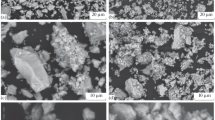Abstract
Electron-probe microanalysis methods were used to study the formation of structure and the distribution of various components in high-porosity powder materials during heat treatment of compacts based on Ni-Fe-NaCl charges mechanically activated in fluid media. We confirmed the hypothesis that agglomerates are formed during mechanical activation of Ni-and Fe-based composite-particle charges in fluid media. A causal relationship was established between formation of structure in compacts and structure of the high-porosity powder material after heat treatment. A technique was proposed for determining the local porosity of the sintered high-porosity powder material. The structure of the high-porosity powder material was found to consist of large pores surrounded by powder material containing pores of smaller diameter.
Similar content being viewed by others
References
Yu. G. Dorofeev, S. N. Sergienko, R. V. Kolomiets, et al., “Effect of mechanical activation of Ni-Fe-NaCl powder charges in liquid media on the structure and properties of high-porosity materials,” Metallurg, No. 11, 63–66 (2007); Metallurgist 51, 631–636 (2007).
V. V. Skorokhod and S. M. Solonin, Physical and Metallurgical Fundamentals of Powder Sintering [in Russian], Metallurgiya, Moscow (1984), 159 pp.
S. I. Shevtsova, A. T. Kozakov, and A. V. Dem’yanchenko, “Use of x-ray spectral microanalysis to determine the amount of surface area occupied by microfissures and pores,” Defektoskopiya, No. 1, 53–57 (1990).
S. I. Shevtsova, A. T. Kozakov, E. G. Fesenko, et al., “Phase identification and study of concentration inhomogeneities in ceramic materials via statistical x-ray spectral microanalysis,” Zh. Anal. Khim. 44, No. 1, 45–50 (1989).
T. A. Pumpyanskaya, V. Ya. Bulanov, and V. G. Zyryanov, Atlas of the Structures of Ferrous Powder-Metallurgical Materials [in Russian], Nauka, Moscow (1986), 264 pp.
Yu. G. Dorofeev, S. N. Sergienko, R. V. Kolomiets, “Kinetics of mechanical/chemical activation in Ni-Fe powder charges,” Fiz. Khim. Obrab. Mater., No. 1, 77–82 (2007).
Yu. G. Dorofeev, S. N. Sergienko, R. V. Kolomiets, “Powder materials based on mechanically and chemically activated Fe-Ni charges and Ni powders,” in: Problems in Modern Materials and Processes, Vestn. Permsk. Gos. Tekhn. Univ., No. 10, 48–52 (2004).
H. J. Hunger, Selected Investigative Procedures in Metal Science [Russian translation from German], Metallurgiya, Moscow (1985), 416 pp. [Springer, New York (1983)].
S. A. Saltykov, Stereometric Metallography, Metallurgiya, Moscow (1976), 274 pp. [1st ed. transl.: Stereometric Metallurgy (1961)].
Author information
Authors and Affiliations
Additional information
__________
Translated from Metallurg, No. 5, pp. 54–57, May, 2008.
Rights and permissions
About this article
Cite this article
Dorofeev, Y.G., Sergeenko, S.N., Kolomiets, R.V. et al. Assessment of porosity and structure of powder materials based on mechanically activated Ni-Fe-NaCl charges. Metallurgist 52, 307–313 (2008). https://doi.org/10.1007/s11015-008-9050-y
Published:
Issue Date:
DOI: https://doi.org/10.1007/s11015-008-9050-y



